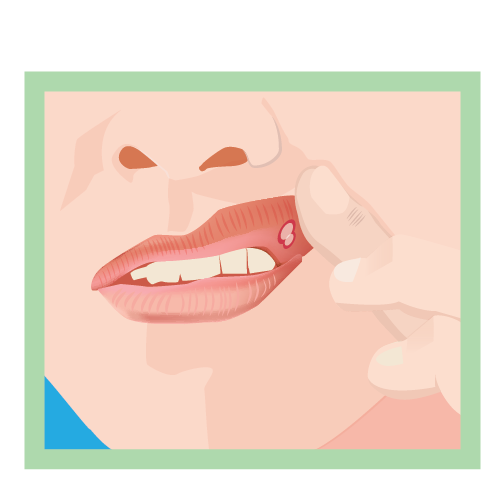Because of drier air, an increase in viral infections and less healthy diet choices around the holidays, you may develop sores in or around your mouth more frequently this time of year.
Canker sores and cold sores are two common types that affect our oral health. Here is a brief explanation of what each is and differences between the two.

Canker Sores (Apthous Ulcers)
Canker sores occur inside the mouth, usually on the cheek lining, tongue, or gums. They are yellowish in the middle with a red edge around them.
There are several things that may contribute to canker sores including biting the inside of the cheeks or tongue, constant dry mouth, a family history of canker sores, low levels of some minerals or vitamins in the diet (iron, folate and B vitamins), and emotional stress. Some experts believe that immune system problems, bacteria or viruses may also be involved in the formation of these ulcers. There is not one exact cause for canker sores, and some people develop them for different reasons than others. It is known that canker sores are not caused by infection and are not contagious.
See your dentist if you have a sharp tooth or dental appliance that causes pain, discomfort or sores to develop.
Although they are not typically serious, long-lasting mouth ulcers (over three weeks) can be a sign of mouth cancer. Get these sores checked out right away.

Cold Sores
Cold sores, which are also called fever blisters, are groups of fluid-filled blisters that occur outside of our mouths in areas around the lips, under the nose or on the chin. Cold sores are caused by the herpes simplex virus type 1. Unlike canker sores, these are very contagious. The initial infection (primary herpes) may be confused with a cold or flu and can cause painful lesions to erupt throughout the mouth. Once a person is infected with primary herpes, the virus stays in the body and causes occasional attacks.
Cold sores often begin with a tingling, itching or burning sensation.
Cold sores usually heal in a week by themselves. Over-the-counter topical anesthetic drugs can provide some relief. Your dentist may prescribe antiviral medicine to reduce these kinds of infections.
What to do if you have one of these?
Canker sores and cold sores can be painful, unsightly, and interfere with proper dental hygiene and/or nutrition. Talk to your dentist if you think you may be developing one of these sores. They can help to relieve the pain or speed up healing.
Sores can also come from poorly fitting dentures if they rub inside your mouth. If you develop sores from your dentures, you should see your dentist to have them fitted properly.
If any mouth sore lasts longer than two to three weeks, seek care at your dental office to ensure they are not caused by or lead to a more serious condition.
This information in this post is for general educational purposes only and does not warrant or represent any information as related to health as specifically appropriate for you. It is not intended to be medical advice or replace the relationship that you have with your health care providers. You should always seek medical advice on any diagnosis or treatment from a qualified health care provider. The information is provided “as is” without any representations or warranties, express or implied.






